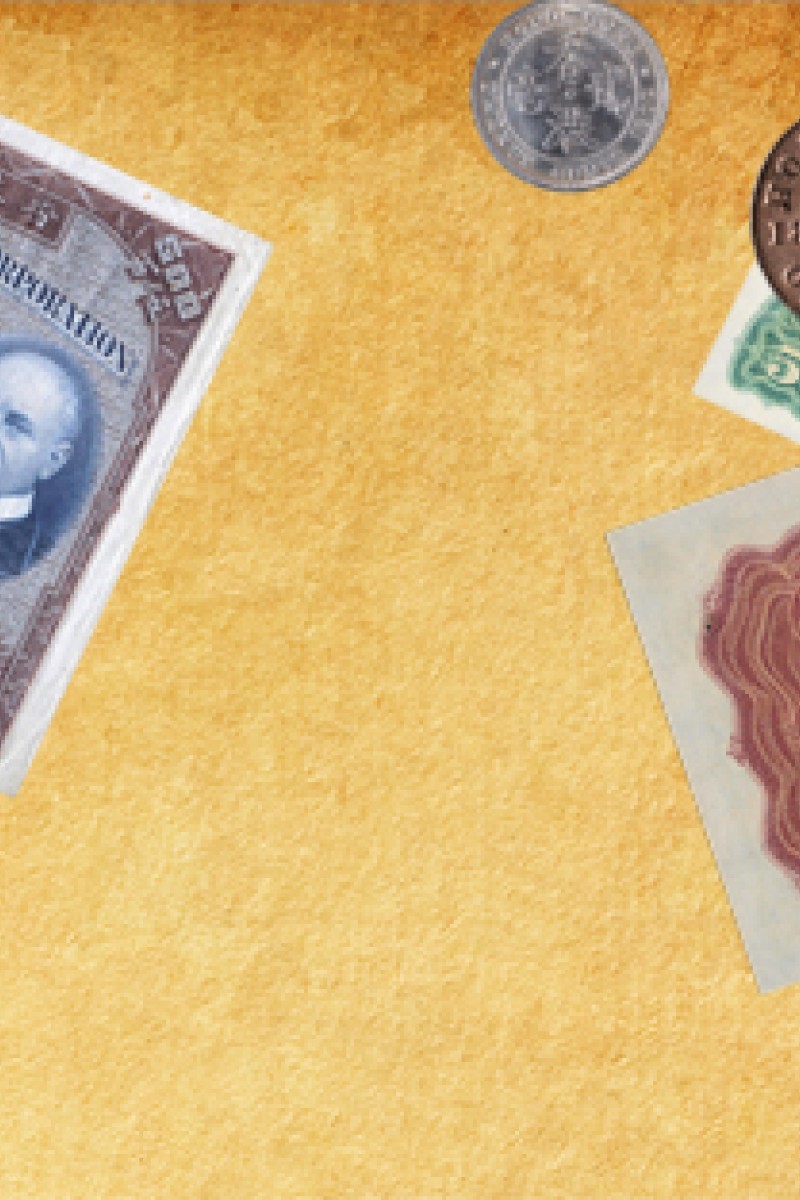 The new exhibition, Hong Kong Currency, reveals the history of the city's money, including a 1935 HK$500 note (top left), two 1941 HK$5 notes (right) and coins, including a gold 1976 Year of the Dragon HK$1,000 piece (left), a 1902 silver 20-cent piece (centre), and an 1863 bronze one-mil coin (right).
The new exhibition, Hong Kong Currency, reveals the history of the city's money, including a 1935 HK$500 note (top left), two 1941 HK$5 notes (right) and coins, including a gold 1976 Year of the Dragon HK$1,000 piece (left), a 1902 silver 20-cent piece (centre), and an 1863 bronze one-mil coin (right).Ingots were not as convenient to use, compared to foreign banknotes, because the value of each ingot varied greatly, making it hard to offer change. So this type of currency vanished from the market after Hong Kong's government dropped the use of the silver standard in 1935.
Visitors to the Museum of History, in Tsim Sha Tsui, can see a new exhibition showing how the old method of payments slowly evolved into its present-day form.
Hong Kong's first bank notes appeared in 1845 - four years after it became a British colony. Coins in Hong Kong followed in 1863. Britain's Royal Mint made coins for its colonies at the time. Hong Kong had a mint on Patterson Street, in Causeway Bay, from 1866 to 1868.
Coins existed in denominations of onedollar, 50cents, 10cents and onecent; the larger a coin's size, the greater its value. They typically bore a profile of the monarch's head on one side.
The smallest denomination of all, a bronze one-mil coin with a hole in the centre, was issued only from 1863 to 1866. It was worth one-tenth of a cent - a thousandth of a dollar. It weighed 0.98g and measured 1.5cm in diameter. The initials "VR", meaning Victoria Regina - Latin for Queen Elizabeth, Britain's monarch - were stamped on the side with English writing, and Hong Kong and one mil were written in Chinese on the other.
As the 1997 handover approached, the Hong Kong government decided to redesign the coins. In 1993, Yam Chi-kong, then chief executive of the Hong Kong Monetary Authority, chose to use the bauhinia, the city's floral emblem.
Coins minted before 1975 are no longer in circulation because they are not a legal currency. The latest coin to be minted by the British authorities, to use up stock before the handover, and found in circulation, was dated 1998.
In the 19th century, coins were not minted to strict standards. Some makers put a hyphen between the words "Hong Kong"; others did not. Writing also came in different styles and sizes.
There was no need for security features when coins were made from silver because their value was expressed by their weight. Fears of counterfeiting arose only when metal alloys replaced silver. To prevent counterfeiting, the Monetary Authority introduced "special edges", like the scalloped edges of HK$2 and 20-cent coins.
The Oriental Bank was the first note-issuing bank in the territory. Banks focused their business then not on savings accounts, but on telegraphic transfers and loans.
The British government required banks to issue notes in multiples of five. The smallest denomination was HK$5; at one time there were HK$25 notes.
"Archives show the exchange rate in 1845 was HK$5 to £1," Osmond Chan Shing-hon, the museum's assistant curator, says. "It made it easier for businessmen when trading between places."
Yet the market was constantly short of HK$1 coins. So the local government made an exception for HSBC, allowing the bank to issue HK$1 notes to satisfy needs. HSBC stopped the practice after the government issued its notes.
"Small-denomination notes tend to have a shorter lifespan than large ones because of their greater circulation," Chan says. "From a businessman's point of view, it is not profitable to replace damaged notes frequently."
The purchasing power of HK$1 has changed over the years. Back in 1971, for example, people paid HK$1.67 for 1kg of top-grade rice; in 2010, they paid HK$10.94.
Like other countries, Hong Kong's coins and notes became smaller over time, making them easier to carry and use. The colour of banknotes issued by different banks also varied. It was not until the Monetary Authority was set up that red became the standard colour of HK$100 notes and blue for HK$20 notes.
Earlier notes sported the note-issuing bank's logo. Some had drawings of legendary figures such as Britannia (the female emblem of Britain) and Roman soldiers. The only real person featured was Thomas Jackson, the former chief manager of HSBC.
The Hong Kong Currency exhibition runs until June 4.
A coloured engraving showing the front view of Hong Kong Mint, which produced coins only from 1866 to 1868 before closure.
